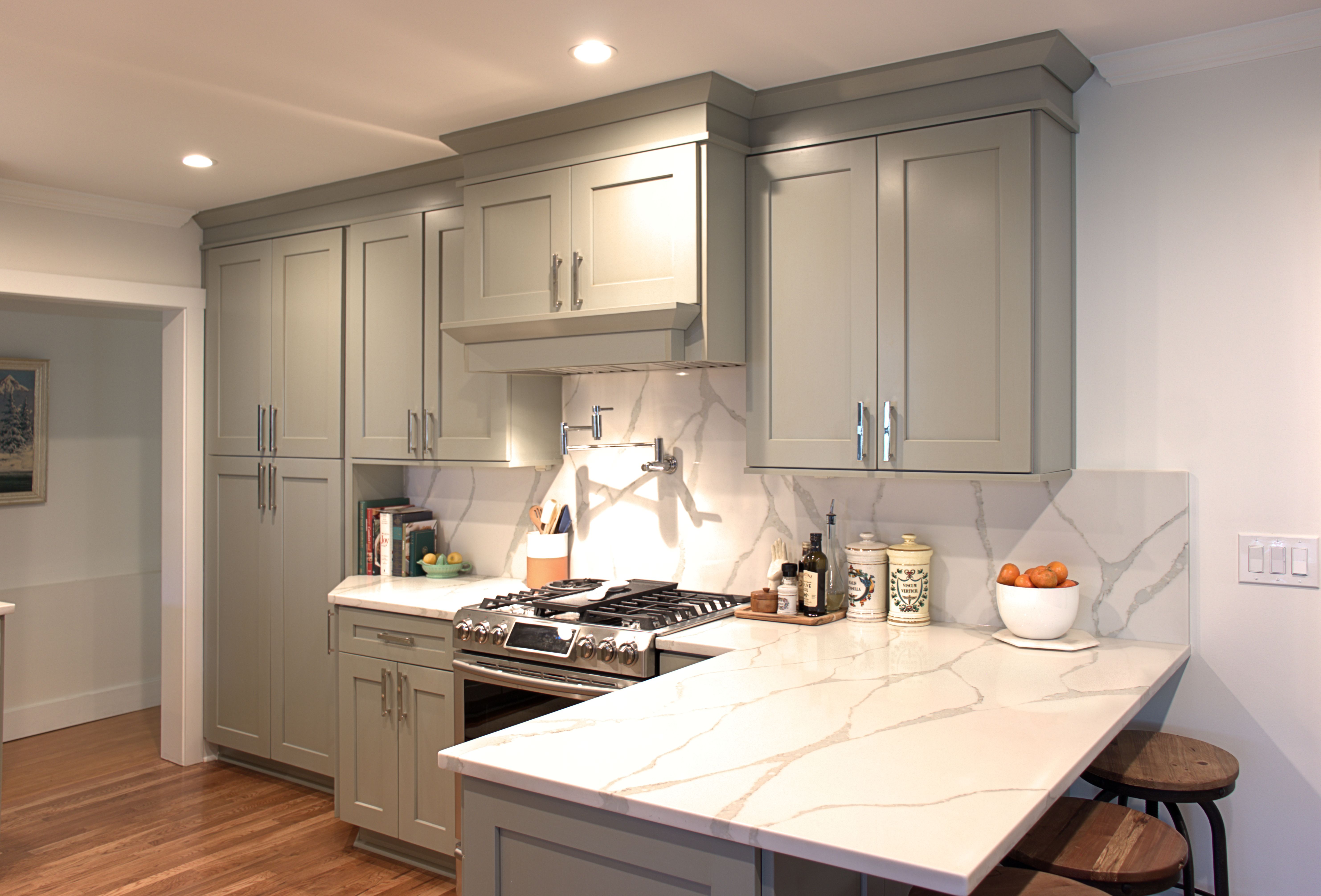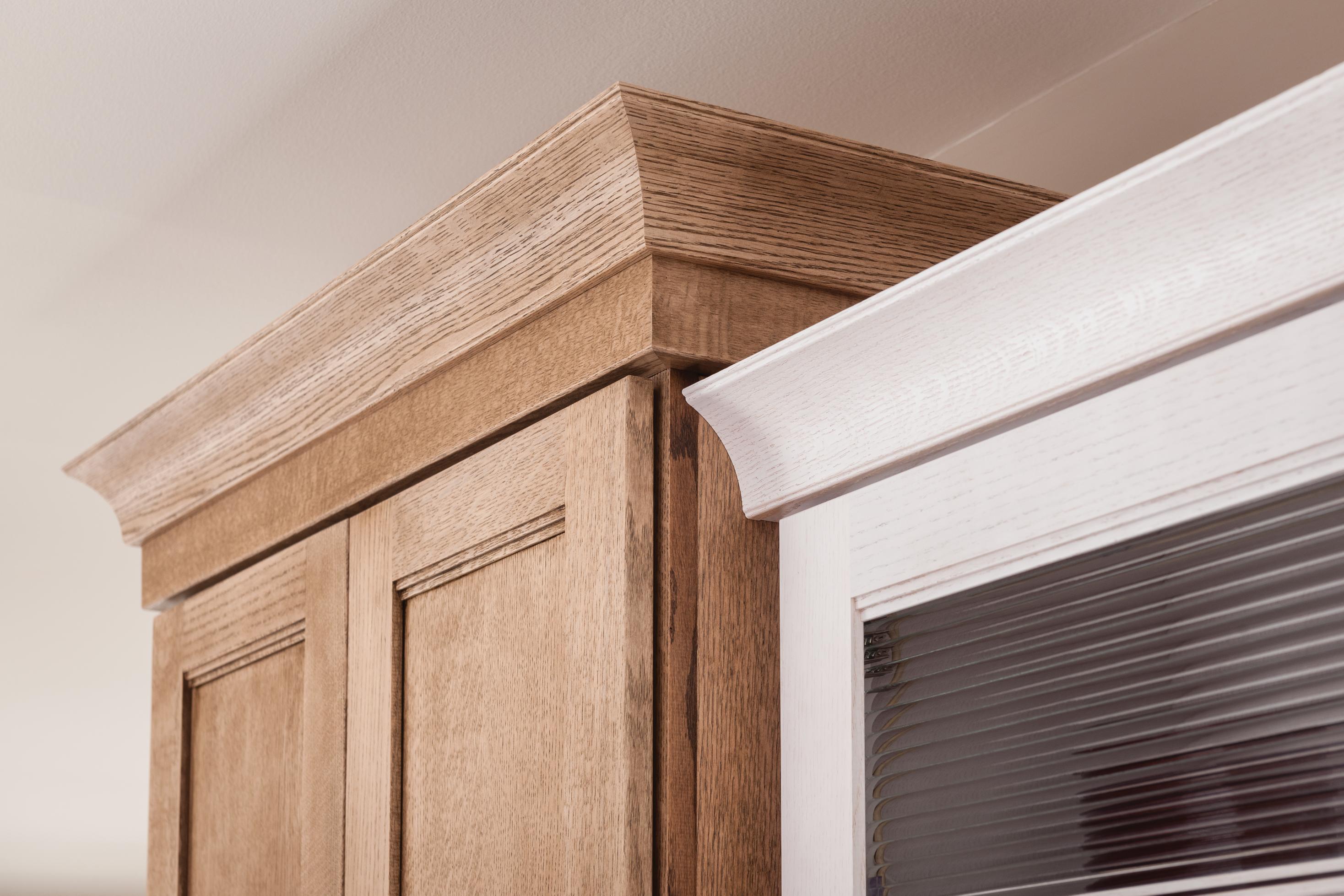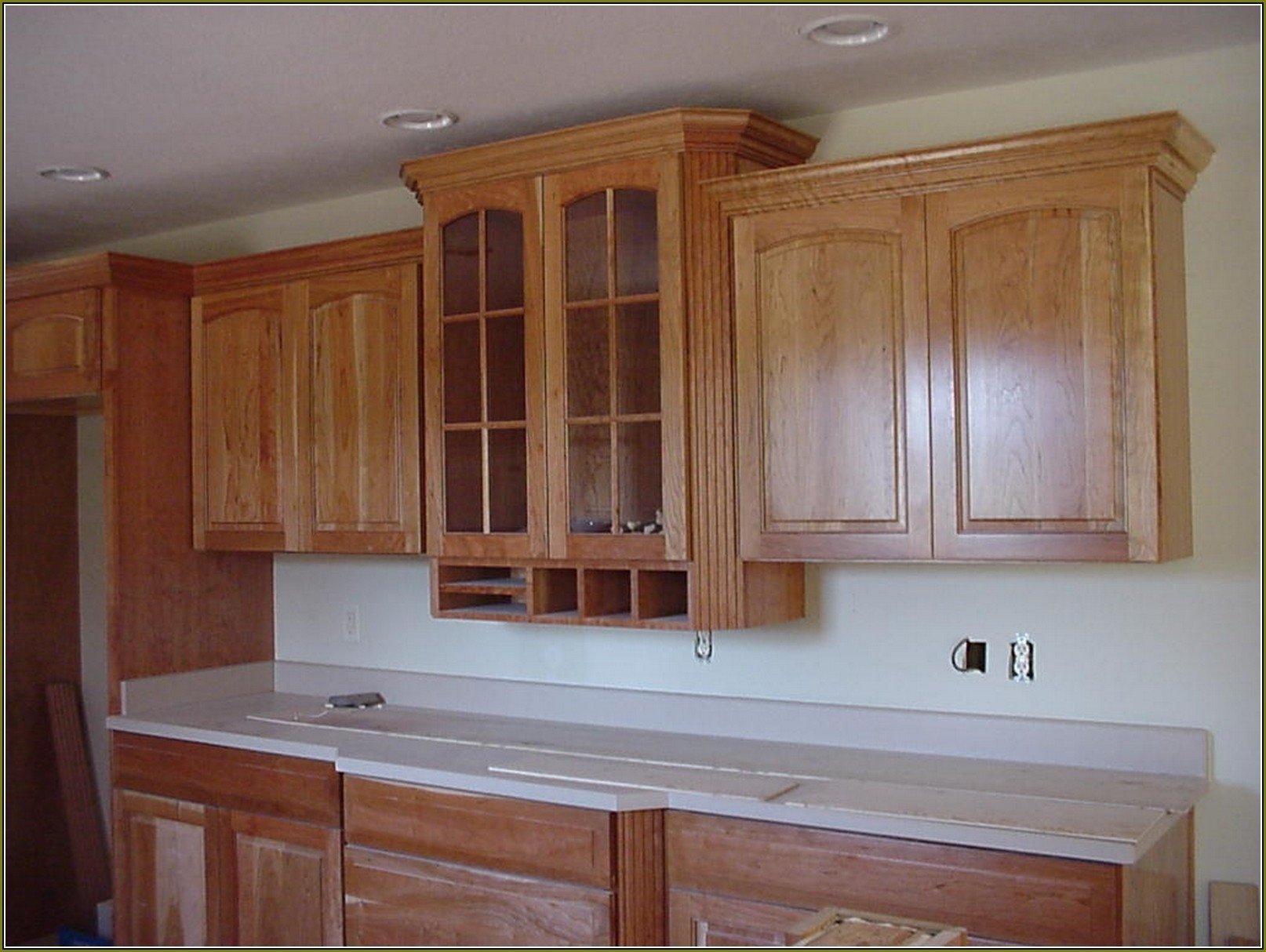Aesthetic Benefits of Kitchen Cabinets to Ceiling with Crown Molding

The decision to extend kitchen cabinets to the ceiling, incorporating crown molding, goes beyond mere functionality. It’s a design choice that can dramatically transform the aesthetic appeal of your kitchen, imbuing it with a sense of sophistication and grandeur.
Visual Impact of Cabinets Reaching the Ceiling
Cabinets reaching the ceiling create a visually striking effect, particularly when paired with crown molding. This design element draws the eye upward, enhancing the sense of verticality and making the space appear taller and more expansive. The seamless flow from cabinet to ceiling, uninterrupted by empty wall space, contributes to a sense of unity and cohesion. The crown molding, acting as a decorative accent, adds a touch of elegance and refinement, complementing the overall design aesthetic.
Crown Molding Styles and Their Impact, Kitchen cabinets to ceiling with crown molding
Crown molding offers a wide array of styles, each contributing a distinct visual character to the kitchen.
- Simple, understated crown molding styles, such as a classic flat profile, are ideal for kitchens with a minimalist or contemporary design aesthetic. They create a clean, uncluttered look, allowing the cabinets to take center stage.
- Elaborate, ornate crown molding styles, featuring intricate carvings and decorative details, are well-suited for kitchens with a traditional or formal design aesthetic. They add a touch of grandeur and sophistication, creating a sense of history and craftsmanship.
- Modern crown molding styles, characterized by clean lines and geometric shapes, are perfect for kitchens with a sleek and contemporary design aesthetic. They add a touch of sophistication and modernity, complementing the overall design theme.
Visual Comparison of Kitchens with and Without Cabinets to the Ceiling
Imagine a kitchen with cabinets that stop short of the ceiling, leaving a significant gap between the top of the cabinets and the ceiling. This gap can appear visually jarring, creating a sense of unfinished space. The empty wall space above the cabinets can also become a magnet for dust and clutter, detracting from the overall aesthetic appeal of the kitchen.
Now, visualize the same kitchen with cabinets reaching the ceiling and adorned with crown molding. The seamless flow from cabinet to ceiling creates a sense of unity and sophistication, drawing the eye upward and making the space appear taller and more expansive. The crown molding adds a touch of elegance and refinement, complementing the overall design aesthetic.
Practical Advantages of Kitchen Cabinets to Ceiling with Crown Molding

Maximizing vertical space with cabinets to the ceiling in your kitchen can significantly enhance both practicality and aesthetics. This approach not only adds a touch of elegance but also provides numerous practical benefits that can make your kitchen more functional and enjoyable.
Increased Storage Capacity and Organization
Having cabinets that extend to the ceiling allows you to take advantage of often-wasted space above standard cabinets. This maximizes storage capacity, providing a solution for a wide range of kitchen items. The additional space can accommodate:
- Seasonal items: Store infrequently used items like holiday decorations, extra cookware, or off-season clothing, keeping your kitchen clutter-free during everyday use.
- Bulk purchases: Stock up on staples like grains, beans, or canned goods without sacrificing valuable counter space.
- Specialty items: Store infrequently used appliances like a stand mixer or food processor, keeping your counters clear and organized.
- Cleaning supplies: Organize cleaning products and tools neatly and out of sight.
By utilizing the entire vertical space, you can create a more organized and efficient kitchen environment, making it easier to find what you need and reducing the need for additional storage solutions.
Minimizing Dust Accumulation and Creating a Cleaner Environment
Cabinets extending to the ceiling eliminate the open space above standard cabinets, which often becomes a dust trap. This significantly reduces the amount of dust that accumulates in your kitchen, making it easier to keep clean and maintain a healthier environment.
“Dusting the top of cabinets is a chore that many people dread. By having cabinets that extend to the ceiling, you eliminate this task entirely, saving you time and effort.”
Cost Considerations
While the benefits of ceiling-height cabinets are undeniable, it is important to consider the associated costs.
- Taller Cabinets: Taller cabinets are generally more expensive than standard cabinets due to the increased material and labor required for their construction.
- Professional Installation: Installing ceiling-height cabinets often requires professional expertise, as they are heavier and more challenging to install than standard cabinets.
Cost-Effectiveness of Maximizing Storage Space
Despite the higher initial cost, ceiling-height cabinets can be a cost-effective solution in the long run.
- Eliminating the Need for Additional Storage Solutions: By maximizing vertical space, you may be able to avoid the need for additional storage solutions like shelves, carts, or storage bins, which can be expensive and take up valuable floor space.
- Increased Efficiency: A well-organized kitchen can save you time and energy, as you can easily find what you need and avoid unnecessary searching. This can improve your overall efficiency and reduce stress in the kitchen.
The cost-effectiveness of ceiling-height cabinets depends on individual needs and preferences. If you are looking for a long-term solution that maximizes storage space and minimizes clutter, ceiling-height cabinets can be a worthwhile investment.
Design Considerations for Kitchen Cabinets to Ceiling with Crown Molding

Installing kitchen cabinets to the ceiling with crown molding presents a unique opportunity to elevate your kitchen’s aesthetics and functionality. This approach maximizes storage space, creates a sense of grandeur, and adds a touch of elegance to the room. However, careful planning and design considerations are essential to achieve a harmonious and visually appealing result.
Kitchen Layout Design
When designing a kitchen layout with cabinets to the ceiling and crown molding, several factors come into play. Room size and ceiling height play a crucial role in determining the overall impact of the design. For instance, in a small kitchen, maximizing vertical space can make the room feel less cramped. Conversely, in a large kitchen, cabinets to the ceiling can create a sense of balance and prevent the space from feeling too vast.
Consider the following aspects when designing your kitchen layout:
- Room Size: In smaller kitchens, maximize vertical space by utilizing cabinets that reach the ceiling. This creates a sense of spaciousness and maximizes storage capacity. In larger kitchens, cabinets to the ceiling can create a sense of balance and prevent the space from feeling too vast.
- Ceiling Height: Cabinets to the ceiling are particularly effective in rooms with high ceilings. This creates a sense of grandeur and utilizes the available vertical space to its full potential. In rooms with low ceilings, consider using shallower cabinets to maintain a sense of openness.
- Desired Aesthetic: The overall aesthetic of the kitchen should guide the design choices. For a modern and minimalist look, opt for clean lines and simple cabinet styles. For a traditional or farmhouse aesthetic, consider incorporating decorative elements such as crown molding, raised panel doors, or decorative hardware.
Choosing the Right Cabinet Style, Finish, and Color
Selecting the right cabinet style, finish, and color is crucial to ensure the cabinets complement the existing kitchen design and create a cohesive aesthetic. The style of the cabinets should reflect the overall design theme of the kitchen.
- Cabinet Style: The cabinet style should complement the overall design theme of the kitchen. For a modern and minimalist look, opt for clean lines and simple cabinet styles. For a traditional or farmhouse aesthetic, consider incorporating decorative elements such as crown molding, raised panel doors, or decorative hardware.
- Cabinet Finish: The finish of the cabinets can greatly impact the overall look and feel of the kitchen. Matte finishes create a more contemporary and understated look, while gloss finishes add a touch of glamour and reflect light. Consider the lighting conditions in your kitchen when selecting a finish.
- Cabinet Color: The color of the cabinets should complement the existing kitchen design and create a cohesive aesthetic. Neutral colors like white, gray, and beige are versatile and can work with a variety of styles. Bold colors like navy blue, emerald green, or deep red can add a touch of personality and create a statement.
Selecting Crown Molding
Crown molding adds a touch of elegance and sophistication to any kitchen. It creates a seamless transition between the cabinets and the ceiling, adding visual interest and a finished look.
- Style: The style of the crown molding should complement the cabinet style and overall kitchen design. For a modern kitchen, consider simple and clean-lined crown molding. For a traditional kitchen, opt for more ornate and detailed crown molding.
- Material: Crown molding is available in a variety of materials, including wood, MDF, and polyurethane. Wood is a classic and durable choice, while MDF is more affordable and easier to work with. Polyurethane is a lightweight and moisture-resistant option.
- Size: The size of the crown molding should be proportionate to the size of the kitchen and the height of the cabinets. In smaller kitchens, consider using a narrower crown molding to avoid making the space feel cramped. In larger kitchens, a wider crown molding can add a sense of grandeur.
Essential Tools and Materials
Installing cabinets to the ceiling and crown molding requires a variety of tools and materials. Having the right tools and materials on hand will ensure a smooth and successful installation process.
- Tools:
- Level
- Tape measure
- Stud finder
- Circular saw or miter saw
- Drill
- Screwdriver
- Hammer
- Safety glasses
- Work gloves
- Materials:
- Cabinets
- Crown molding
- Cabinet hardware
- Wood screws
- Construction adhesive
- Caulk
- Paint or stain
Kitchen cabinets to ceiling with crown molding – Taking your kitchen cabinets to the ceiling with crown molding adds a touch of elegance, but don’t forget the importance of choosing the right style for your cabinets. If you’re in the Fall River area, be sure to check out the fall river kitchen cabinets selection for inspiration.
With the right cabinets and crown molding, your kitchen will be the envy of all your neighbors – even the ones who insist on open shelving.
Taking your kitchen cabinets to the ceiling with crown molding adds a touch of elegance and maximizes storage space. If you’re in the Peachtree City, GA area, you’ll find a wealth of options for kitchen cabinets, kitchen cabinets peachtree city ga , from sleek modern to rustic farmhouse.
And remember, those crown molding details will make your cabinets the envy of the neighborhood, even if they are just filled with mismatched Tupperware.
